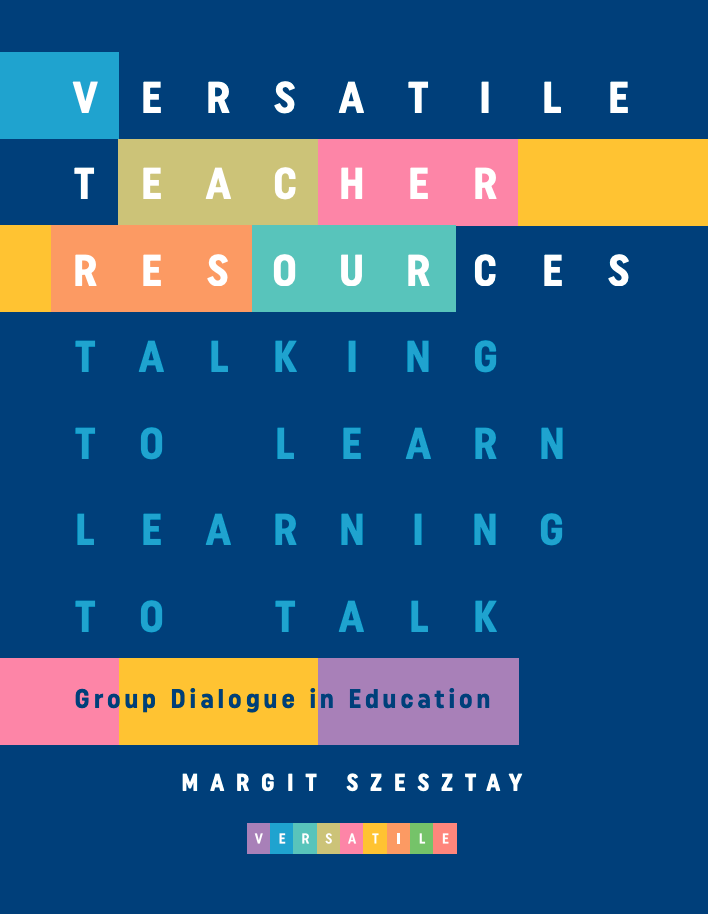- Home
- Publications
- Talking to Learn Learning to Talk by Margit Szesztay, reviewed by Sharon Hartle, Italy
Talking to Learn Learning to Talk by Margit Szesztay, reviewed by Sharon Hartle, Italy

A Versatile Teachers’ Resource book
published in 2020 by Versatile Publisher
Brno. Czechia
“Talking to learn Learning to Talk” is an extremely practical teachers’ resource book, which focuses on the ‘facilitation skills’ that can enrich mainstream teaching skills. The book explores a post-constructivist approach to teaching and learning, where teachers and learners interact to build and extend their learning by means of dialogue, and in particular what David Bohm defines as “group dialogue”. Creating this type of dialogue, in fact, is not only a matter of interacting but also developing an awareness of how we, both as teachers and learners, interact, communicate and express our ideas, listen to those of others and to think critically. The author of the book, Szesztay, groups activities, for instance, in categories such as “How I see myself, How the group sees me” or “How habits can block dialogue and how dialogue can change habits”. As such the book provides both food for thought and a range of practical materials for educators at all levels.
Margit Szesztay, the author, is a Hungarian teacher and trainer in the field of English Language Teaching (ELT), with thirty years of experience. One of her major interests, which is reflected in this book, is “learning through discussion” and she underlines the influence of her own language learning experience. As a teenager in the USA initially with “no English”, as she explains (p.vi) she was often in the position of an observer, which helped her to empathize with learners who may also feel like outsiders when struggling to communicate with limited language resources. The materials in this book, in fact, have emerged as a result of insights gleaned from countless dialogues with students colleagues, family and friends together with the influence of authors such as Covey, Goleman, Senge, Stevick, Mercer, Tannen, Duhigg, Janis, Bohm and Rogers among others. An informative foreword is provided by Adrian Underhill as well.
The book is organised in two main sections. The first part provides six sub-sections that explore the theoretical ideas and insights that Szesztay bases her activity framework on, with suggested activities and links to other sections in the book. The second part is a collection of sixteen different ways of implementing different interactions and group dynamics such as “Blocks to listening” or “Listening guidelines” . These practical activities serve as models that can be adapted in a variety of different ways in different classrooms and educational contexts.
There are also useful ‘How to Use this Book’ and ‘Lesson Preparation’ sections as well as a companion website that teachers can access freely to extend the work in the book. It is written in an accessible way and the overviews of the activities are all linked to specific communication matters such as ‘Activity 6: Group Intelligence’, which aims to tap into the way groups develop their own collective intelligence or ‘Activity 8: Why people stay silent’ which underlines the fact that silence is a part of communication and individuals may choose to not speak for a variety of reasons, moving on then to explore ways in which such silent participants may be brought back into the conversation. The aims of the activities are introduced briefly, with links back to the relevant parts in the first part of the book, and then worksheets or procedures are outlined. This book was being written in 2020 when the world was in various states of lockdown and education moving into distance learning. For this reason, reference is also made to dialogue online and how the activities originally intended to be used face to face in a physical classroom context can be adapted for the digital one. The approach is extremely innovative and will be useful for all teachers, both those seeking to understand why problems in group dialogue occur but also those interested in fostering more effective communication in the classroom.
Underhill, in the foreword to this book, says that “group dialogue is not just a nice-to-have, but a necessity”. This recognises the essential role of language, not only as a system to be learned but as an essential part of the human beings involved in the process of learning. By raising awareness of how such a dialogue can be developed Szesztay contributes to the process of communication which is crucial, particularly in our globalised world at this point in time, and the development of which, as she herself says is not simply a tool acquired in childhood but a “lifelong process”(p.1).
In a world which is constantly, at the moment, being coloured by the fears and impositions being brought about by the pandemic, this book focuses on communication, and how to improve it, which is a skill that is so badly needed both in educational fields but also in the wider contexts of geopolitics, which affect us all. Szesztay’s style is clear and direct and may be just what we need to start to shift our perspective towards new skills and solutions.
Please check the How to teach spoken English course at Pilgrims website.
Please check the Practical Methodology and English Language Development for Secondary Teachers course at Pilgrims website.
Please check the Practical Ideas for Teaching Advanced (C1-C2) Students course at Pilgrims website.
Humans in the Classroom by Haili Hughes
News from Pavilion
Short Book Reviews
Hanna Kryszewska, PolandTalking to Learn Learning to Talk by Margit Szesztay, reviewed by Sharon Hartle, Italy
The Tune Into English
Fergal Kavanagh, Italy